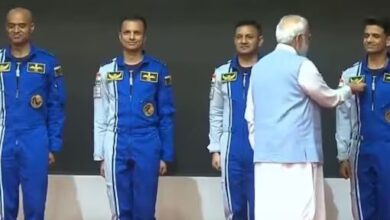
- The final approach phase of the LEX mission was completed at the same time as the re-entry flight path, which showed an autonomous, high-speed (350 kmph) landing.
- ISRO wants to cut the cost of putting a payload into low earth orbit by 80%, so they are planning more experiments to make sure that the RLV works.
Sunday, the Indian Space Research Organisation (ISRO) ran a successful test that it said would help the country get closer to its goal of sending reusable rockets into space.
The “Reusable Launch Vehicle Autonomous Landing Mission (RLV LEX)” was done by the space agency at the Aeronautical Test Range of the Defence Research and Development Organisation (DRDO) in the Chitradurga district of Karnataka.
“India was able to do it! “, the agency for space said on Twitter. “ISRO, with help from @DRDO India @IAF MCC, ran the Reusable Launch Vehicle Autonomous Landing Mission (RLV LEX) successfully… ”
RLV’s autonomous approach and landing pic.twitter.com/D4tDmk5VN5
— ISRO (@isro) April 2, 2023
ISRO says that the RLV took off as a load on the bottom of an Indian Air Force Chinook Helicopter. When it got to an altitude of 4.6 km, it was set free to land on its own on a runway.
The agency also said that such a method had never been used before.
ISRO said that the experiment was done just like a space re-entry vehicle would land, with “high speed, unmanned landing from the same return path.”
It said, “The experiment was done as if the vehicle had come from space.”
ISRO chairman Dr. S. Somanath said that the success of the experiment brought India closer to having its own rockets and landing craft that can be used again and again for different missions.
“The very first experiment (of the RLV landing experiment program) went well. I’m sure that it meets almost all of the goals that were set for the landing experiment a long time ago,” he said, adding that it was a great chance for ISRO to make an Orbital Landing Experiment.
The RLV is basically a space plane with a low lift-to-drag ratio. It had to land at high speeds of 350 km/h because it had to approach at high glide angles. ISRO said that the LEX used a number of systems made in India.
ISRO made “localized navigation systems based on pseudolite systems, instrumentation and sensor systems, etc.,” according to the space agency. “Adapting modern technologies made for RLV LEX makes ISRO’s other operational launch vehicles more cost-effective,” the agency said.
ISRO’s HEX Mission in May 2016 was the first time that the RLV-TD, a vehicle with wings, came back to Earth. During that test, the vehicle landed on a made-up runway over the Bay of Bengal because “precise landing” on a runway was not part of the HEX mission. ISRO said, “The final approach phase of the LEX mission was completed at the same time as the re-entry flight path, which showed an autonomous, high-speed (350 kmph) landing.”
ISRO wants to cut the cost of putting a payload into low earth orbit by 80%, so they are planning more experiments to make sure that the RLV works. Plans are also being made for the Return Flight Experiment and other tests of the RLV.
Sunday, the Reusable Launch Vehicle (RLV) Autonomous Landing Mission (LEX) was done successfully at the Aeronautical Test Range of the Defence Research and Development Organisation (DRDO) in Chitradurga, Karnataka.







Facebook Comments